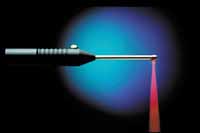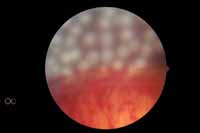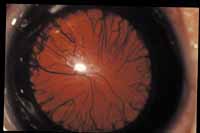Transscleral diode laser coagulation effectively treats threshold ROP
The method may be an alternative to transpupillary coagulation in eyes with cataract formation risk.
December 2000
TAORMINA, Italy — Transscleral diode laser coagulation is a safe and effective method for treating threshold retinopathy of prematurity (ROP), according to Volker Seiberth, MD, who spoke at the Jules Gonin Club meeting here.
“Laser treatment seems to present fewer side effects than cryotherapy and to be just as effective,” Dr. Seiberth said. “However, transpupillary laser treatment bears an increased risk of cataract formation in a number of predisposed cases. We have, therefore, tested transscleral application as an alternative method of retinal photocoagulation, in which the laser energy is conveyed through the sclera and choroid, circumventing the lens.”
The study
 ---Laser probe for
transscleral diode laser coagulation.
---Laser probe for
transscleral diode laser coagulation.
“We performed a controlled clinical study involving 25 preterm infants with bilateral threshold ROP,” Dr. Seiberth explained. “One eye was treated with transscleral diode laser coagulation, and the other eye was treated with transpupillary diode laser coagulation.”
The birth weight of patients ranged from 510 g to 1,200 g. Gestational age was 24 to 29 weeks. The average follow-up was 3.2 years, with a range of 2.1 to 5.7 years.
The diode laser used was an Iris Medical OcuLight SLx (Iridex Corp., Mountain View, U.S.A.). For transscleral treatment, the diode laser light was delivered by a retinopexy probe (Iris Medical DioPexy; Iridex).
Surgery was performed in both eyes consecutively in one session, with the patients under general anesthesia. The spot size was about 1,000 µm.
“Transscleral laser coagulation of the peripheral avascular retina (zone III or peripheral zone II) was easily performed through the conjunctiva. However, central zone II and zone I were difficult to reach with the straight probe in such small eye globes, and small conjunctival incisions were necessary in 21 of the 25 eyes,” Dr. Seiberth said.
No suture was applied, as conjunctival wounds closed spontaneously in all infants.
In the same session, transpupillary coagulation was performed in the fellow eye using an indirect ophthalmoscope delivery system (Iris Medical LIO 500, Iridex). Spot diameter was 480 µm. No conjunctival incision was needed.
Comparable results
“With both treatments, in 24 of the 25 eyes, vascular proliferation regressed after a single laser application, and the retina was flat and attached,” Dr. Seiberth said. “In one case, a second transpupillary treatment was necessary and led to complete regression. Only one case of transscleral treatment had an unfavorable outcome, due to particularly difficult preoperative conditions.”
No adverse events were reported as a result of either transpupillary or transscleral laser treatment. There were no corneal, iris or lens burns, nor unintentional retinal burns. No lens opacities or cataracts developed with either treatment. Only minor postoperative conjunctival bleeding or swelling was observed in some of the transsclerally treated eyes. Minor retinal bleeding occurred in the area of the ridge in nine of the eyes treated with transscleral coagulation and five of the eyes treated with transpupillary coagulation.
 |
 |
| Fundus photograph showing laser spots after transscleral diode laser coagulation in threshold retinopathy of prematurity. | Chorioretinal scars after transscleral diode laser coagulation in ROP. Vascular proliferation has completely regressed. |
 | |
| Tunica vasculosa lentis in an eye of a preterm infant. In these eyes transpupillary laser coagulation may be risky. Transscleral coagulation is advantageous in these eyes. | |
“The infants were seen on the first postoperative day and then weekly until ROP had receded completely,” Dr. Seiberth said. “Thereafter, we checked them monthly until 6 months and then quarterly. Results were stable in all cases. Two infants died after 2 months, but their retinas were attached, and ROP had regressed.”
From about age 2 years, best-corrected visual acuity (BCVA) of each eye was measured. At a mean follow-up of 3.2 years (range 2.1 to 5.7 years), mean BCVA was 0.35 (range NLP to 1) in the transsclerally coagulated eyes and 0.39 (range: 0.1 to 1) in the transpupillary coagulated eyes. Transsclerally treated eyes were insignificantly more myopic, with a mean spherical equivalent of –5.2 D (range +2.75 to –16.25 D), compared with a mean spherical equivalent of –4.3 D (range +3.5 to 14.75 D) in the transpupillary coagulated eyes.
Conclusions
 ---Schematic drawing of
transscleral laser photocoagulation.
---Schematic drawing of
transscleral laser photocoagulation.
“Our study showed that transscleral diode laser coagulation can be considered as effective as transpupillary coagulation,” Dr. Seiberth said. “In all eyes except one (due to particularly adverse conditions), ROP regressed completely, and no significant differences were shown in BCVA and refractive error between transscleral and transpupillary coagulated eyes.”
“However, although the consequences are minor and transient, transscleral coagulation is in fact more traumatic than transpupillary treatment. Conjunctival incisions are necessary if a broad avascular area is present, and this may cause some minor bleeding and swelling of the eyelid and conjunctiva. In all of our young patients, these symptoms disappeared within 7 days.”
The true advantage of transscleral coagulation comes from the circumvention of the lens, which avoids the risk of lens opacification and cataract development.
“Though the incidence of cataract formation is probably low, a lens-sparing method is preferable in eyes that are predisposed to this complication. This may apply to eyes with pre-existing cataract, with iris pigment adherent to the anterior lens capsule, with iris lens synechiae, with small pupils or with insufficient pupil dilation,” Dr. Seiberth said.
For Your Information:
- Volker Seiberth, MD, is head of Osnabrück Eye Clinic and a lecturer at Heidelburg. He can be reached at Marienhospital Osnabrück, Johannisfreiheit 2-4, 49074 Osnabrück, Germany; +(49) 541-326-4402; fax: +(49) 541-326-4412. Dr. Seiberth has no direct financial interest in the products mentioned in this article, nor is he a paid consultant for any companies mentioned.
- Iridex Corp. can be reached at 1212 Terra Bella Ave., Mountain View, CA 94943 U.S.A.; +(1) 650-940-4721; fax: +(1) 650-962-0486; e-mail: info@iridex.com.
